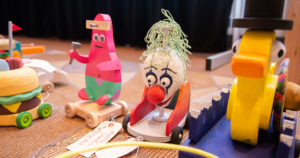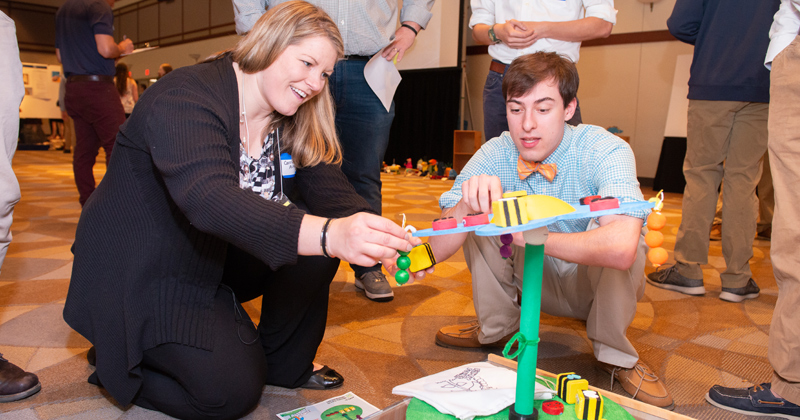Students design and build toys, pitch to Melissa and Doug representatives
Engineering students at the University of Delaware recently pitched their own inventions to representatives from a major toy company.
A trio of professionals from Melissa and Doug, a toymaker with revenue of more than $350 million per year, visited UD in May to evaluate toy prototypes made by mechanical engineering students with help from early childhood education students. Companies like Melissa and Doug employ mechanical engineers because they have foundations in product design, mechanics, dynamics and other skills that are useful when making tiny consumer products.
Student-designed toys
The students made toys that were functional, fun and educational, like the Carpet Circuit, which was designed to teach the basics of circuitry.
“The challenge was: How do we take a concept that is usually taught to 8-to-12-year-olds and teach it to 4-year-olds?” said team member Chase Neuberth, a sophomore mechanical engineering student.
The team created a mat that can be laid on a classroom floor or hung from a chalkboard. The mat is covered with detachable pieces — held on with Velcro — that illustrate the basics of electronics. For example, you can connect a battery-shaped piece to a lightbulb-shaped piece using a rope that represents a wire.
Another toy, the Farmyard Friends Puzzle, a 12-piece 3D pig-shaped puzzle, was designed to increase literacy by helping children recognize letters while also developing fine motor skills. Each piece of the wooden puzzle features uppercase and lowercase letters. The team is also interested in making a prototype out of 3D printed polymer.
The representatives from Melissa and Doug asked the Farmyard Friends Puzzle team a lot of questions — and asked for more information after the showcase.
“Before today, I didn’t know our toy was at a level that Melissa and Doug would express interest,” said team member Allison Procak, a sophomore mechanical engineering student. “This is more than a class project — it can be used in the real world.”

First-year mechanical engineering students designed and fabricated these wooden pull toys.
Learning the basics
Before they could build their prototypes, students in UD’s Computer-Aided Engineering Design course learned the foundations of modeling, drafting and more.
For example, Jenni Buckley, associate professor of mechanical engineering, asked students to brainstorm attributes, such as safety and durability, that engineers at Melissa and Doug might consider when imagining new toys.
“Kids are rough with stuff,” Buckley said. “Stuff needs to hold up.”
Under federal law, all toys sold in the United States must meet American Society for Testing and Materials (ASTM) F9963 safety standards. Among other requirements, toys must be sized so that kids can’t choke on them. Corners and edges must be rounded so that no one sustains a cut.
Buckley demonstrated tests that can help engineers meet these standards. For example, during a “choke test,” engineers place each toy part inside a cylinder that simulates a child’s esophagus to ensure that parts can’t become lodged entirely inside the child’s throat.
Once all the safety concerns are figured out, there is another important matter to attend to — fun.
“We could make things that are awesome, safe and durable for that age range, but that doesn’t mean they will use them,” Buckley said. “What attributes might we want to include so that kids actually use it?”
Buckley encouraged engineering students to think about the number of parts, size of parts, and the appearance of their toys. It’s important to consider the shape and thickness of the parts and size of the features.
Then there are production considerations.
“What manufacturing process am I going to use? What process am I using? Can I make these things in bulk?” Buckley said.
To solve these problems, students rely on engineering theory, some basic physics, computer-aided design, quick experiments and benchmarking. Then they select materials and think about how the toy would be mass produced. Will it require computer-automated cutting, which is more expensive than the traditional press?
Students, split into teams of four to five, used computer-aided modeling software to sketch out their toys. Then they built and tested their prototypes in the Design Studio, a nearly 6,000-square-foot space in UD’s Spencer Laboratory.
To make sure their designs were developmentally appropriate with an educational twist, engineering student teams were paired with consultants — students taking Early Childhood Inclusive Science Curriculum and Assessment, a course in the College of Education and Human Development. Toys were also tested by real kids in UD’s Lab Preschool and College School.
At the May showcase, Jennifer Gallo-Fox, assistant professor of human development and family sciences, praised the designs for their educational content.
“We are really impressed by the way you took feedback and thought about the developmental aspects of things that children can learn from working with toys and also the educational components in terms of content areas,” she said.
Jill Fenniman, a junior studying early childhood education, was recognized for providing outstanding help and insight throughout the semester.
Impressing the experts
The representatives from Melissa and Doug got a glimpse of the ingenuity of UD students.
Rich Rivellese, national accounts sales analyst at Melissa and Doug, works with retailers, tracking sales and inventory to assess how toys should be stocked. He said the students’ efforts to do consumer research and understand their customers stood out.
“They spoke to moms, they spoke to kids, they tested in preschools, so they were really thinking about the end user,” he said.
Carrie Aitkenhead, education outreach coordinator at Melissa and Doug, connects with teachers and schools to encourage play in the classroom. She praised the interdisciplinary nature of this project, which paired UD engineering students with education students so that they could all learn from each other and optimize their end product.
“It really comes back to what we do, where there’s not just one set of people making something,” she said. “It’s really a different set of people consulting each other and collaborating, and I think those collaborations were really evident in how great the products were.”
Drew Humphrey, talent acquisition manager at Melissa and Doug, is involved in hiring new employees. He said he was impressed with the level of detail of the students’ creations.
“These guys have a really bright future in front of them,” he said. “The ability to present and do what they did today is something that will serve them throughout their careers and wherever they go.”

HDFS students work with children at UD’s children’s campus to test the prototypes developed by the mechanical engineering students.
A bounty of prototypes
First-year mechanical engineering students at UD created wooden pull toys that were also displayed on May 15. Aitkenhead praised the simple but beautiful design of one blue toy that evoked images of water exploration.
“Whatever a child does when they pick up this toy, they pick up this toy and they bring their experience,” she said. “They might say, ‘this is a mom, this is a baby.’ They might say: ‘this is an uncle and me when we go fishing.’ They bring their experience to the toy.”
Students from the Discover Engineering class at Padua Academy, a private high school in Wilmington, also created prototypes for the showcase.
“I like that they were able to present their hard work and see what they would do as engineers,” said teacher Cheri Szurkowski.
The students at Padua spent part of their spring vacation building their toys in UD’s Design Studio, which is equipped with 3D printers, woodworking equipment, metalworking equipment and more.
“That experience is just invaluable,” she said. “Most high schools don’t have that type of equipment.”


